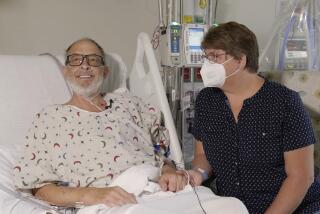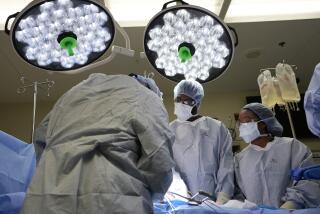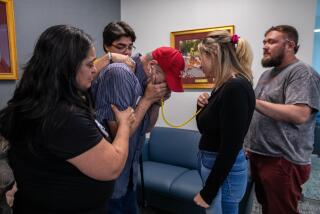BODY WATCH : Mending Broken Hearts : Dr. Hillel Laks of UCLA repairs diseased hearts that ordinarily would be rejected for transplant. And the recipients are usually 65 to 70, people who might not otherwise be eligible.
- Share via
How do you mend a broken heart?
Dr. Hillel Laks does it at a moment’s notice, rushing to a surgical suite at UCLA Medical Center, where he works feverishly over a single, silent heart--freshly removed from a donor--while, nearby, a very sick person awaits a second chance at life.
In one of the most innovative and controversial developments since the advent of heart transplantation 28 years ago, Laks and his colleagues have devised a way to repair diseased hearts that typically would be rejected for transplant. Furthermore, the recipients are usually elderly individuals who might be turned down for transplants because of their age.
“We came up with this program to help people between the ages of 65 and 70,” says Laks, who has mended 10 donor hearts since 1992. “And, so far, these patients are faring very well.”
A complex set of medical and ethical rules governs transplantation in the United States. But generally, younger recipients tend to get younger, healthier hearts. And because the list of heart recipients far exceeds donors, people 60 and older often do not qualify for transplants. They are excused because of their age and because their chances of survival are considered worse.
The “alternative donor” program, now being practiced at other major U.S. transplant centers, gives these people a chance.
“One of the biggest problems we face is the shortage of donor hearts,” says Laks, director of the UCLA Heart Transplant Program--the nation’s largest--and chief of cardiothoracic surgery. “Originally, everyone with life-threatening heart disease was put on the waiting list. But as the list grew, it wasn’t good enough to have one-third or even one-half of these people die while waiting.”
As of last month, 2,938 people in the United States were registered on the heart transplant waiting list, according to the United Network for Organ Sharing. In 1993, the most recent year in which figures are available, 2,299 received a heart.
Donor shortages have grown more acute in recent years due to stricter seat belt, air bag, and motorcycle and bicycle helmet laws, which have reduced traffic-related deaths.
“The source of donors from car accidents has really declined,” says Laks, whose office walls bear rows of textbooks and framed photos of transplant recipients.
In 1988, the average American waited 108 days for a transplant. Nationwide, that wait now averages 208 days, according to UNOS. At UCLA, a person in dire need of a heart waits an average of four weeks while someone with a less-urgent need waits an average of one year.
And time still runs out for many.
That’s why Laks and his colleagues decided to take a big chance in March, 1992. A 53-year-old woman was pronounced brain-dead at another hospital. Brain-death is the optimal condition in which to obtain a donor heart because the individual, while clinically dead, can be kept on life-support equipment, allowing the heart to function.
The woman had no history of heart disease, and yet a coronary arteriogram--a picture of the heart--showed blockages in her arteries, which is common as people age. Blocked arteries reduce blood supply to the heart.
But the heart was otherwise healthy and functioned well. The UCLA team wanted it because, in their intensive-care unit, a 68-year-old Artesia man was close to death from heart disease.
“He was going downhill fast,” Laks says.
While the heart was en route to UCLA, surgeons removed veins from the man’s legs. After the heart arrived, Laks took the veins and performed a quadruple bypass on the organ, replacing the clogged arteries. Within an hour, the mended heart was transplanted.
That first surgery was controversial. But since then, the practice of performing bypass surgery on donor hearts has gained support, says Dr. Jon Kobashigawa, co-director of the heart transplant program at UCLA.
“These patients have been doing very well,” says Kobashigawa, who cares for transplant recipients after surgery. “Their survival rates are comparable, and they have very few rejections and infections.”
While older patients may not do as well over time--Laks says that remains to be seen--the alternative program has already taught surgeons something about both the heart and older recipients.
“It’s a very flexible organ,” Kobashigawa says. “It rebounds easily. Of course, we are starting off with a heart that has good function, so we don’t really lose anything.”
And, Laks says: “There have been many patients we have accepted with risk factors (such as age) that suggest they won’t do well, and they have ended up some of our best patients. So we feel we have to give patients the benefit of the doubt.”
*
The success of the alternative program has raised an ethical dilemma on using age as a criterion for transplants. Most transplant programs will not consider people older than 60 or 65. In 1993, only 103 of the 2,299 heart recipients nationwide were older than age 65.
“There are many programs that feel the sicker patients may be the ones who most need a good heart. But many of those older, sicker patients are being turned down for a transplant at other hospitals,” Laks says.
Moreover, as Americans live longer, who is to say that a 65-year-old with a transplanted heart might not enjoy another 20 or 25 years of life?
“The ethical issue is, can we put a value on the basis that one recipient is a father with young children and the other recipient is 65 and retired?” Laks says. “We feel the onus on us, as doctors, is to identify which patients will benefit with a particular heart.”
With the alternative program, UCLA generally accepts transplant candidates up to age 70, although Laks recently evaluated a 72-year-old man for a possible transplant.
And, in 1993, a donor heart requiring bypass surgery was transplanted into a 70-year-old man with heart failure who had already spent three weeks in the intensive-care unit.
“He had the transplant and was discharged from the hospital seven days later,” Laks says. “He is still fine two years later. He could easily have been turned down for a transplant.”
When alternative hearts become available, patients are told of the organ’s condition and are offered the option to remain waiting for a perfect heart. Most choose to proceed with the alternative heart. Repairs on the heart add another 45 to 50 minutes to the time when the heart is arrested--adding an additional risk to the equation. But doctors have been successful in stretching the precious time that a donor heart can remain viable, Laks says.
Researchers have also made significant progress in determining which people absolutely need a transplant and which can benefit from another type of treatment. Until recently, surgeons believed that every person with severe heart disease needed a transplant. But studies show that bypass surgery and other operations often increase the time an individual can survive before needing a transplant.
For example, one woman with severe heart disease underwent bypass surgery twice over an eight-year period before she underwent a transplant, Laks says.
Doctors have also learned that patients with ventricular arrhythmia--a dangerously irregular heartbeat--who were almost always candidates for quick transplants, now can be kept alive with an implantable defibrillator device.
“These advances improve the medical therapy and made us more discriminating as to who needs transplants,” Laks says.
Still, doctors say their biggest challenge is the shrinking donor pool and the resistance many people still have about becoming organ donors.
“The best way to improve the number of donors is public awareness,” Kobashigawa says. “It’s like advertising. We have to continue our presence.”






